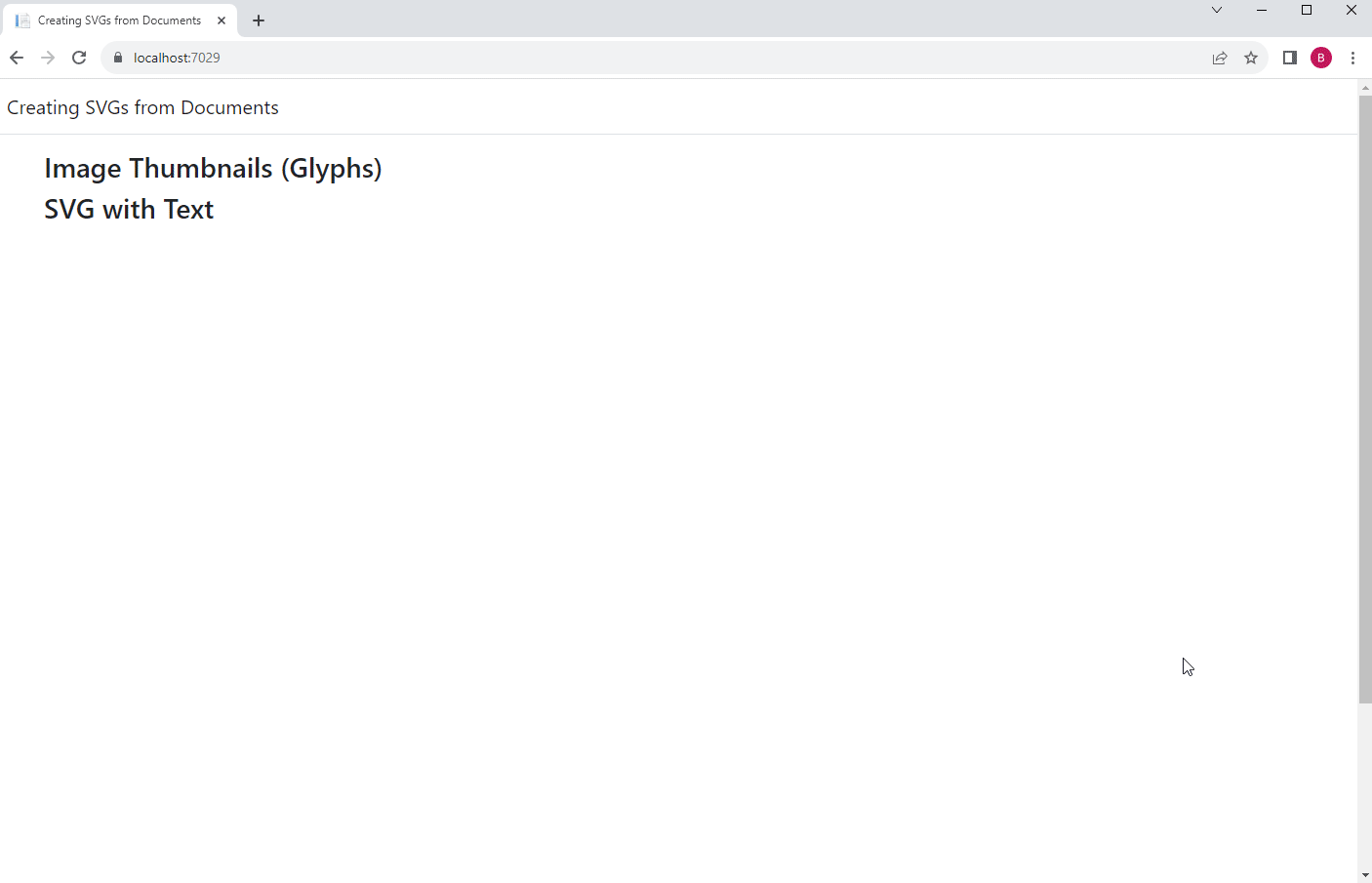How to Generate SVG Images from Document Pages in ASP.NET Core C#
TX Text Control can be used to generate SVG images from the page of a document, including documents such as MS Word DOC and DOCX. The sample application for creating thumbnails and selectable SVGs is described in this article.

Scalable Vector Graphics (SVG) is an XML-based vector image format developed and maintained by the World Wide Web Consortium (W3C). TX Text Control is not only able to insert SVG images into a document, but it can also be used to generate SVG images from the pages of a document.
The advantage of SVG is that it's a standard that's supported by all browsers, and because it's a vector graphics format, there's no loss of quality for text content.
The Page.
string svgSources = tx.GetPages()[1].GetImage(TXTextControl.Page.PageContent.All, 300);The first parameter PageContent defines the content to be returned by the method and the second parameter defines the resolution of embedded bitmap images.
Text as Splines
Text is exported as glyphs when using TXTextControl.Page.PageContent.GlyphOutlines. This means that the fonts will be exported as splines in the generated SVG and will be rendered in a consistent, platform-independent manner.
The following example shows the output of the rendered text as path elements in the SVG file.
<svg
xmlns="http://www.w3.org/2000/svg"
xmlns:xlink="http://www.w3.org/1999/xlink" x="0" y="0" width="11906" height="16838">
<defs>
<clipPath id="𝒯✗_C1">
<path d="M0,1134h11906v14570h-11906z"/>
</clipPath>
</defs>
<path fill="rgb(255,255,255)" d="M0,0h11906v16838h-11906z"/>
<g clip-path="url(#𝒯✗_C1)">
<path id="𝒯✗_0_0" d="M1186,1317l0-126-47,0 0-17 113,0 0,17-47,0 0,126z"/>
<path id="𝒯✗_0_1" d="M1273,1317l0-143 18,0 0,51c8-9 18-14 30-14 8,0 14,2 20,5 5,3 9,7 11,12 3,5 4,13 4,23l0,66-18,0 0-66c0-9-2-15-5-19-4-4-9-6-16-6-5,0-9,1-14,4-4,3-7,6-9,11-2,5-3,11-3,19l0,57z"/>
<path id="𝒯✗_0_2" d="M1383,1193l0-19 18,0 0,19zm0,124l0-104 18,0 0,104z"/>
...The actual text and font information is present in the SVG if the content is exported as text.
<svg
xmlns="http://www.w3.org/2000/svg"
xmlns:xlink="http://www.w3.org/1999/xlink" x="0" y="0" width="11906" height="16838">
<defs>
<style>.𝒯✗_fnt0{font:200px Arial;}</style>
</defs>
<path fill="rgb(255,255,255)" d="M0,0h11906v16838h-11906z"/>
<text x="1134 1259 1369 1412 1513 1568 1612 1712 1768 1878 1933 2034 2144 2315 2425 2468 2579 2634 2744 2855 2956 3066 3236 3347 3457 3512" y="1317" class="𝒯✗_fnt0" xml:space="preserve">
This is a sample document.
</text>
</svg>Sample Application
The sample application implements Web API methods to return SVG images from loaded documents. The CreateSVG method loops through the pages specified by a start page and an end page in order to create SVG images.
public string[] CreateSVG(ServerTextControl TextControl,
bool GlyphOutlines = false,
int FromPage = 1,
int ToPage = -1)
{
// create array for SVGs
string[] svgPages = new string[(ToPage == -1 ? TextControl.Pages : ToPage)];
// set page content
TXTextControl.Page.PageContent pageContent =
GlyphOutlines ? TXTextControl.Page.PageContent.All | TXTextControl.Page.PageContent.GlyphOutlines
: TXTextControl.Page.PageContent.All;
for (int i = FromPage; i <= (ToPage == -1 ? TextControl.Pages : ToPage); i++)
{
// get SVG from page
svgPages[i - 1] = TextControl.GetPages()[i].GetImage(pageContent, 96);
}
return svgPages;
}This method is called by the Web API endpoints. It creates a Server
[HttpGet]
public string[] GetSVG()
{
lock (_lock)
{
using (TXTextControl.ServerTextControl tx = new ServerTextControl())
{
tx.Create();
tx.Load("App_Data/demo.tx", StreamType.InternalUnicodeFormat);
// create SVGs from all pages with glyph outlines
var svgs = CreateSVG(tx, true, 1, -1);
// convert SVGs to Base64 strings
for (int i = 0; i < svgs.Length; i++)
{
byte[] bytes = Encoding.UTF8.GetBytes(svgs[i]);
svgs[i] = Convert.ToBase64String(bytes);
}
return svgs;
}
}
}On the client side, these endpoints are called asynchronously and the returned SVGs are created as image elements and appended to a container.
// ajax call to get the svg with glyphs
$.ajax({
url: '@Url.Action("GetSVG", "Home")',
type: 'GET',
dataType: 'json',
success: function (data) {
console.log(atob(data[0]));
// for each element in data array
$.each(data, function (index, value) {
// create img element
var img = document.createElement('img');
img.className = 'svgImage';
img.src = 'data:image/svg+xml;base64,' + value;
img.width = 200;
// append to container
$('#imageContainer').append(img);
});
}
});Download the sample application from our GitHub repository to test it yourself.
![]()
Download and Fork This Sample on GitHub
We proudly host our sample code on github.com/TextControl.
Please fork and contribute.
Requirements for this sample
- TX Text Control .NET Server
- Visual Studio 2022
ASP.NET
Integrate document processing into your applications to create documents such as PDFs and MS Word documents, including client-side document editing, viewing, and electronic signatures.
- Angular
- Blazor
- React
- JavaScript
- ASP.NET MVC, ASP.NET Core, and WebForms
Related Posts
Adding SVG Graphics to PDF Documents in C# .NET
In this article, we will explore how to add SVG graphics to PDF documents using C# .NET. We will use the TX Text Control .NET Server component to demonstrate the process of rendering SVG images in…
ASP.NETASP.NET CoreServerTextControl
The Importance of PDF Signing in .NET C#
More than ever, documents are being shared, edited, and stored electronically. A digitally signed PDF is a document that has been signed using cryptographic technology to verify that the document…
Convert MS Word DOCX to SVG in .NET C#
This article demonstrates how to convert a Microsoft Word DOCX file to SVG in .NET C#. This concept can be used to convert DOC, DOCX, and RTF files to SVG using the TX Text Control.
When to Generate Documents Server-Side Instead of Client-Side: A Focus on…
When it comes to document generation, deciding whether to handle the task server-side or client-side is a key architectural decision for any organization. This article discusses the benefits of…
Sign Documents with a Self-Signed Digital ID From Adobe Acrobat Reader in…
This article shows how to create a self-signed digital ID using Adobe Acrobat Reader and how to use it to sign documents in .NET C#. The article also shows how to create a PDF document with a…







